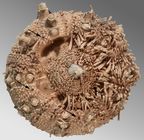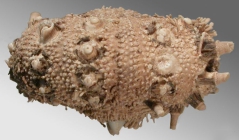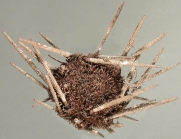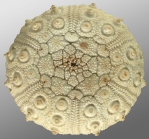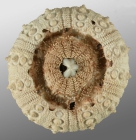WoRMS name details
Echinophyces Mortensen, 1909
1471619 (urn:lsid:marinespecies.org:taxname:1471619)
uncertain > taxon inquirendum
Genus
Echinophyces mirabilis Mortensen, 1909 (type by monotypy)
- Species Echinophyces mirabilis Mortensen, 1909 (uncertain > taxon inquirendum)
marine, brackish, fresh, terrestrial
recent only
neuter
Mortensen, T. (1909). Die Echinoiden der Deutschen Südpolar-Expedition 1901-1903. <em>XI. Band, Zoologie III.</em> 1-114., available online at https://www.biodiversitylibrary.org/page/6727415
page(s): 16 [details]
page(s): 16 [details]
Taxonomic remark Mortensen (1909) described a putative parasitic filamentous microorganism living in the spines of Antarctic cidaroid sea...
Taxonomic remark Mortensen (1909) described a putative parasitic filamentous microorganism living in the spines of Antarctic cidaroid sea urchins, which was interpreted to be able to induce drastic morphological changes, particularly to the reproductive system of the host echinoids, differentiating putatively infected specimens from uninfected conspecific individuals. Mortensen tentatively interpreted the putative parasite as fungus. MicroCT analyses of "infected" specimens (David et al. 2009) suggest that the filaments protruding from the spines are calcitic extension of the cortex and have to be regarded as microstructural characteristic of the echinoid. Unpublished molecular analyses by Susan Lockhart (cited in David et al. 2009) indicate that the "infected" specimens with "transformed" morphology formerly attributed to the effect of the putative parasite were indeed not closely related to "normal" specimens of the species they were identified as. She suggested the new genus Miracidaris (an unavailable name) for the "transformed" specimens. Take together these results strongly suggest that specimens interpreted as infected by Echinophyces mirabilis are not conspecific with the species they have been traditionally attributed to and that the filaments of the supposed parasite are actually part of the spine microstructure. The name Echinophyces mirabilis might thus be simply based on a misinterpretation of an unusual morphological feature. According to David et al. (2009), Lockhart, however, did state that the Echinophyces mirabilis exists and is a symbiont on primary spines of some cidaroid echinoids with possible affinity to the Orthonectida. Additional analyses are necessary to verify this interpretation. [details]
Kroh, A.; Mooi, R. (2024). World Echinoidea Database. Echinophyces Mortensen, 1909. Accessed through: World Register of Marine Species at: https://www.marinespecies.org/aphia.php?p=taxdetails&id=1471619 on 2024-04-20
Date
action
by
![]() The webpage text is licensed under a Creative Commons Attribution 4.0 License
The webpage text is licensed under a Creative Commons Attribution 4.0 License
original description
Mortensen, T. (1909). Die Echinoiden der Deutschen Südpolar-Expedition 1901-1903. <em>XI. Band, Zoologie III.</em> 1-114., available online at https://www.biodiversitylibrary.org/page/6727415
page(s): 16 [details]
page(s): 16 [details]
From editor or global species database
Taxonomic remark Mortensen (1909) described a putative parasitic filamentous microorganism living in the spines of Antarctic cidaroid sea urchins, which was interpreted to be able to induce drastic morphological changes, particularly to the reproductive system of the host echinoids, differentiating putatively infected specimens from uninfected conspecific individuals. Mortensen tentatively interpreted the putative parasite as fungus. MicroCT analyses of "infected" specimens (David et al. 2009) suggest that the filaments protruding from the spines are calcitic extension of the cortex and have to be regarded as microstructural characteristic of the echinoid. Unpublished molecular analyses by Susan Lockhart (cited in David et al. 2009) indicate that the "infected" specimens with "transformed" morphology formerly attributed to the effect of the putative parasite were indeed not closely related to "normal" specimens of the species they were identified as. She suggested the new genus Miracidaris (an unavailable name) for the "transformed" specimens. Take together these results strongly suggest that specimens interpreted as infected by Echinophyces mirabilis are not conspecific with the species they have been traditionally attributed to and that the filaments of the supposed parasite are actually part of the spine microstructure. The name Echinophyces mirabilis might thus be simply based on a misinterpretation of an unusual morphological feature. According to David et al. (2009), Lockhart, however, did state that the Echinophyces mirabilis exists and is a symbiont on primary spines of some cidaroid echinoids with possible affinity to the Orthonectida. Additional analyses are necessary to verify this interpretation. [details]

